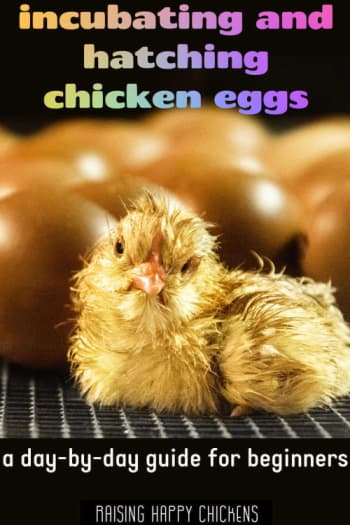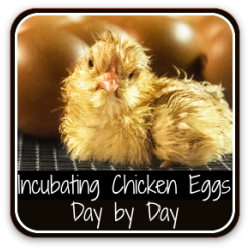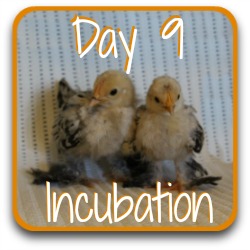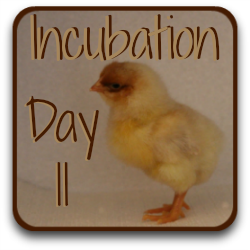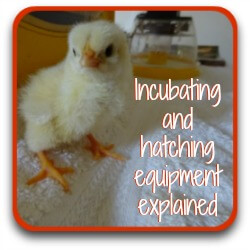- Home
- Incubation day by day
- Day 10
Chicken eggs incubation at Day 10.
What's happening in the egg, how is the chick developing, what tasks should we be undertaking, what can go wrong?
By day 10 the chick is well formed. The basic body structure is relatively recognisable, the spinal chord and brain are established and the heartbeat is strong enough to be recognised with a specialist chicken egg heart rate monitor (yes, there really is such a thing and of course, I have one! see sources).
Chicken eggs incubation: what's going on in the egg today?
- If we could open the egg today and take a look inside (which we can't, of course!) we'd see the chick at this stage of incubation looks a bit like a tiny alien.
- The eyes and the beak would be immediately obvious: they both look much too big for the body.
- One of the most surprising things about today is that the feather tracts for the chick's flight feathers start to develop.
- Because these feather tracts are already developed when the chick hatches, chicks will show wing feather growth amazingly early after hatching – on some breeds as early as three days post-hatch.
- Below is one of my Golden Laced Wyandotte chicks at day 4 in the brooder, showing the tiny wing feathers growing.
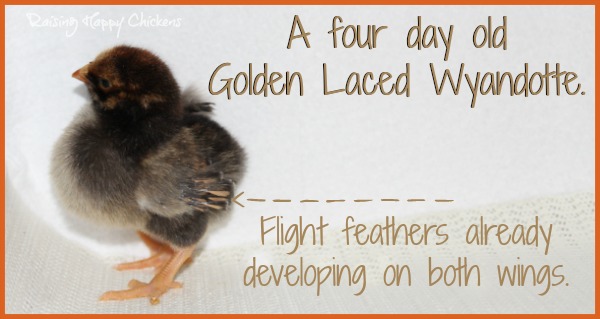
What's happening to the chick at day 10?
- Much of the facial development from yesterday continues today.
- The eyelids enlarge and the lower one grows upwards.
- The nose opening is growing and narrowing.
- The beak continues to harden.
Please note: the image below is a commissioned piece and is subject to international copyright laws. I am the sole copyright owner.
It must not be used, copied or reproduced anywhere without my permission.
Contact me for details and permissions for this and all other images on this page.
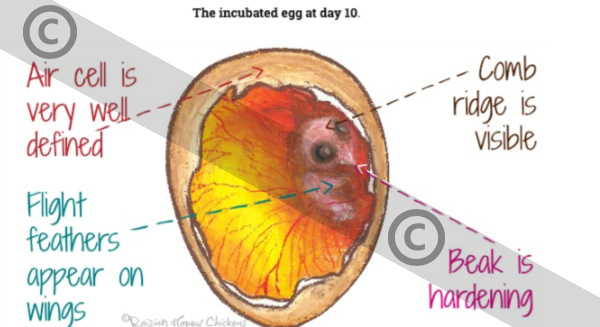
- Elsewhere on the body, the ridge where the comb will grow is forming
- The toes, which are now separate, begin to grow claws at the end.
- The chorioallantoic membrane, which was 80% closed yesterday, is complete today and now surrounds the yolk.
- This membrane is critical. It allows oxygen to be brought to the embryo and carbon dioxide and urine to be taken away.
Chicken eggs incubation: what can we see if we candle the egg now?
- Especially in light-coloured eggs, candling may show the chick moving about. This is due to the heartbeat, which is now strong, pushing the body around the amniotic fluid.
- The heartbeat is around 220 – 240 beats per minute (see sources), although this will vary considerably depending on temperature and humidity, which massively affect the rate of development.
- It's becoming more difficult to see exactly what's going on the egg, because the embryo is now growing quickly and beginning to fill the space where once we could identify blood vessels.
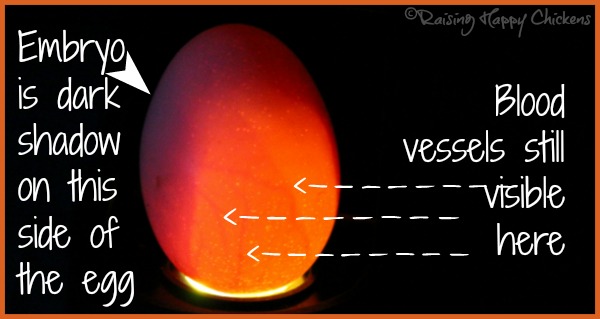
- Even with the colour and saturation levels altered on the photograph it's still not possible to see much, although the blood vessels and the embryo are clearer.
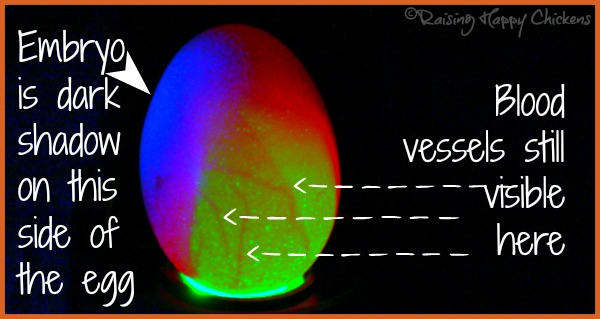
What should we be doing today?
- Today we should candle any eggs which have previously shown no signs of development, particularly in light shelled eggs.
- If development has started, the signs should by now be clear, even if you can't see much detail.
- If you want to check others for continuing growth, that's fine.
- Make sure you mark the air cell again so that it's clear it's growing. Air cell markings will also become important as we get close to hatching.
- If you've never candled before and want to know how, take a look at this page before you go any further. It will open in a separate window so you can return here to know what you're looking for when you do candle.
Can anything go wrong at this stage of chicken eggs incubation?
As the eggs get further into incubation the shell become more porous, allowing the blood system to take in enough oxygen to keep the embryo alive.
For that reason it's very important that, if you candle, you make sure everything, particularly your hands, is spotlessly clean.
Bacteria entering the eggs is disastrous for hatch levels. In a warm, moist environment like an incubator bacteria multiply very quickly and eggs will become bad, potentially exploding and releasing bacteria into all the other eggs in the incubator.
Always keep a bottle of a good quality hand sanitiser on your incubating table. (This is an affiliate link, which means that if you click and buy a product, I earn a small commission).
Chicken eggs incubation: question of the day.
I've just candled my eggs again and there are some which look as though they're not developing. Should I discard them now?
Certainly if the eggs have a white or other light coloured shell, you can see the contents easily, and there is no obvious development, the chances are it will not develop now.
As long as it's not smelling or oozing liquid, though, it's fine to leave it for a couple more days if you really can't bear to discard it.
Below is an egg I candled at day 7 and saw no development whatever. Note the 'X' mark at the top which is my shorthand for 'no signs of anything'.
But I candled again at day 12 (this pic) and there was clearly an embryo in there. See the dark spot which is the chick's eye, and the developing blood supply?
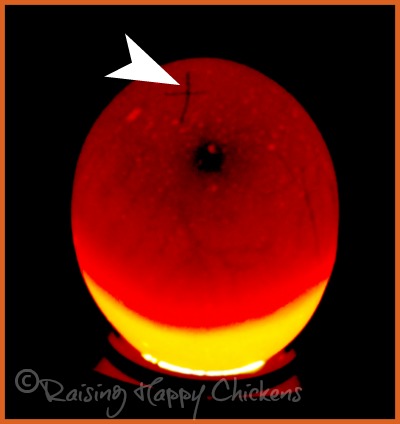
This egg developed successfully, and hatched into a Light Sussex chick – the larger of the two in the photo below. (The other is one of my Lemon Millefleur Sablepoot chicks).
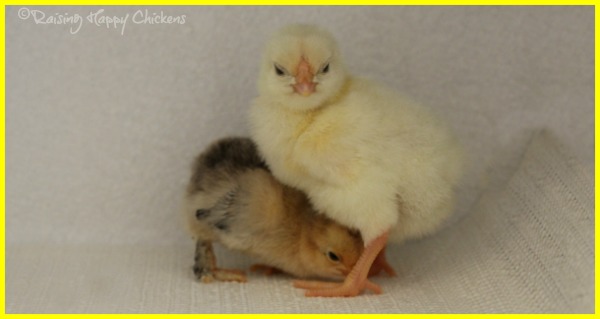
Personally, if I have an egg which I'm unsure about at day 10, I mark it and candle again at day 14. If there is still no sign then – discard.
The exception to this is dark-coloured shells like the Marans, which are virtually impossible to see inside, even with a strong candling light. These I keep until the end of incubation, as long as they are showing no signs of deteriorating.
Chicken eggs: incubation at different stages.
These links will help whether you want to return to the very start of this day-by-day course (button link #1), or if you need to refresh your memory about yesterday (day 9 button link). Otherwise, use the third button to move forward to tomorrow, day 11 of incubation.
More information about incubating and hatching chicken eggs.
Sources.
A lot of "facts" you'll find on the internet are often people's individual views, based on inaccurate information repeated from poor quality sources.
The information I provide in this article and others is based on both my own experience of incubating and hatching chicken eggs every year for over 13 years, but on evidenced facts from scientific, peer-reviewed research and books from highly respected and experienced poultry keepers such as Gail Damerow.
Some of the trusted sources I have used in this article are these.
Avitronics: Heart Rates. Pub. Avian ID, 2020.
Damerow, Gail: Hatching and Brooding Your Own Chicks. Pub. Storey, 2013. See my review, here.
Hall, C., et al: A new candling procedure for thick and opaque eggs and its application to avian conservation management. Pub. Journal of Zoobiology, 2022.
Hamburger, V and Hamilton, H L: A series of normal stages in the development of the chick embryo. Pub. Journal of Morphology, 1951.
Pescatore, T, and Jacob, J.: Development of the Chick. Pub. University of Kentucky, College of Agriculture, 2019.
Swann, G., and Brake, J.: Effect of Incubation Dry-Bulb and Wet-Bulb Temperatures on Time of Hatch and Chick Weight at Hatch. Pub. Journal of Poultry Science, 1990.
Tona et al: Chicken Incubation Conditions: Role in Embryo Development, Physiology and Adaptation to the Post-Hatch Environment. Pub. Frontiers in Physiology, 2022.
- Home
- Incubation day by day
- Day 10
